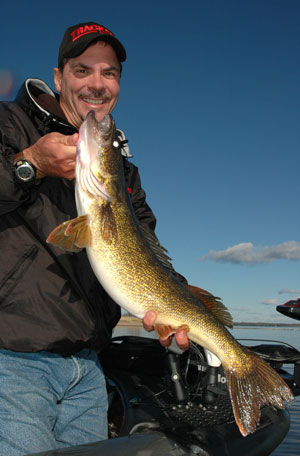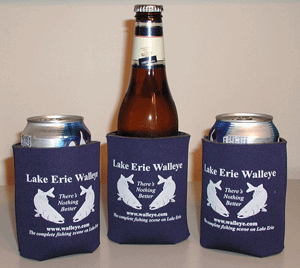|
Get The Lead Out
for Contour Cranking
By
Keith Kavajecz and Gary Parsons
At first glance,
trolling crankbaits for walleyes seems like a simple task … toss out a couple of lures, let out a bunch of line, pop the
motor in gear and you’re trolling … NOT! Proper trolling technique
requires precision at many levels. First of all you need to know the
precise depths of the walleyes that you’re targeting. Then you need to
understand precisely what set-up is needed, to get precisely the right
bait, to precisely the right depth, at precisely the right speed, to
trigger the fish. Sound complicated? It can be, especially when
walleyes are scattered along sharp breaks, and not relating specifically
to a particular depth, but more of a “depth range”. We already know
your question, “With all of your years of tournament angling
experience, you guys must have developed a way to cover multiple depths
efficiently to catch these fish." Precisely!
task … toss out a couple of lures, let out a bunch of line, pop the
motor in gear and you’re trolling … NOT! Proper trolling technique
requires precision at many levels. First of all you need to know the
precise depths of the walleyes that you’re targeting. Then you need to
understand precisely what set-up is needed, to get precisely the right
bait, to precisely the right depth, at precisely the right speed, to
trigger the fish. Sound complicated? It can be, especially when
walleyes are scattered along sharp breaks, and not relating specifically
to a particular depth, but more of a “depth range”. We already know
your question, “With all of your years of tournament angling
experience, you guys must have developed a way to cover multiple depths
efficiently to catch these fish." Precisely!
The technique is
known as "contour trolling". Unlike "open water trolling", where baits
are trolled over open water in search of suspended fish, contour
trolling targets walleyes relating to structure. Baits are trolled in a
manner to maintain their depth in close proximity to the bottom, while
following the contour of the structure holding the greatest numbers of
fish.
It’s a scenario
that plays out on many walleye waters, particularly large reservoirs.
Walleyes relating to a shallow break along the old river channel in the
upper stretches of the reservoir. The break may go from four to eight
feet, flatten out for a short distance, and then drop off into deeper
water. Fish may be scattered all along the break, not really
concentrating in any particular spot, so trolling becomes the most
efficient method of contacting the greatest number of fish. Now if the
walleyes were to be all been sitting in the same depth, say six feet of
water along the break, it would make it a relatively simple task to pick
a lure that would run just off the bottom with a particular length of
line out to pick off fish on each trolling pass. However, its much more
typical for the fish to not only scatter along the length of the break,
but up and down the break as well. Some could be hanging at the top of
the break, while others will be sitting off the deep edge. The
challenge becomes finding a way to cover the entire depth range without
constantly adjusting the amount of line out for the lures to follow the
contour. The answer is a tactic most anglers would only consider a "deep
water" technique … trolling lead core line.
Trolling lead core
in this situation gives you several advantages. First of all it allows
the use of small crankbaits, which often mimic the preferred forage this
time of year, while still letting you cover multiple depths. In many
reservoirs, breaks like this will be littered with snags, and the
smaller baits have a tendency to glance off obstructions and snag less
often than larger lures. Lead core's large diameter and water
resistance also makes it very "speed sensitive". Slowing the boat speed
allows the lead core to sink, taking the trailing lure deeper.
Conversely, speeding up causes water to "push" the lead core up,
allowing the angler to fish a lure shallower. Therefore, instead of
constantly adjusting the amount of line out to cover varying depths,
simply changing the trolling speed allows for movement of the lures up
and down the break.
Another advantage
to using lead core on structure is the fact that it has no stretch,
making it very sensitive. Anytime you're fishing tight to the bottom,
there's the chance your lure is going to pick up debris, causing it to
lose its action and making it useless for catching fish. By combining
the lead core with a leader of no-stretch FireLine, it's easy to monitor
the bait's action by watching the rod tip. If the lure picks up a leaf
or other bottom debris, the rod tip will stop vibrating, letting you
know its time to reel that bait in and clean it off.
Let’s say you want
to fish a shallow break, say four to eight feet deep … the water is
dingy water and the contour is rather complex (a common situation on
many walleye reservoirs). A good set up would be to run 30 feet of lead
core with a ten foot leader of FireLine. That may seem like a short
leader to most anglers familiar with lead core trolling, but in this
scenario it’s absolutely the best way to go. The short leader gives the
lead core more control over the bait's depth and path, allowing you to
work the lure in and out of small cups and contours along the break. On
the other hand, if you're dealing with clear water and less "snaky"
contours, a longer leader would be a better choice. The same pattern
will work on deeper structures as well, like a break going from fifteen
to eighteen feet. It's just a matter of letting out more lead core.
Of course fishing
with lead core does require having the right equipment. Since lead core
is so bulky, large capacity reels like the Bass Pro Shops Gold Cup Line
Counter GC4000LCB Trolling Reel are a must. As for the rods … long
trolling rods with soft tip sections and moderate actions are ideal for
absorbing head shakes and bulldog runs of a fish hooked well behind the
boat. The Walleye Angler Signature Series 8'6" Trolling Rod available
from Bass Pro is a perfect match for the Gold Cup Reel, creating a great
combo capable of handling all of your lead core trolling presentations.
Would this be
considered an unconventional trolling method? Maybe … but walleyes can
be very unconventional adversaries. Being consistently successful at
catching walleyes requires versatility, precision and the occasional
unconventional thought. It’s a matter of fitting the presentation to
the situation at hand. We know this somewhat unconventional use of lead
core for trolling shallow structure works well … after all, it’s
accounted for some great tournament finishes for us, including Keith’s
2002 PWT Championship win and was a contributing factor in Gary’s 2003
PWT win on Lake
Oahe. If you're serious about catching
walleyes, and you haven't experimented with trolling lead core, you owe
it to yourself to check it out. It's a versatile and deadly
presentation! |





 task … toss out a couple of lures, let out a bunch of line, pop the
motor in gear and you’re trolling … NOT! Proper trolling technique
requires precision at many levels. First of all you need to know the
precise depths of the walleyes that you’re targeting. Then you need to
understand precisely what set-up is needed, to get precisely the right
bait, to precisely the right depth, at precisely the right speed, to
trigger the fish. Sound complicated? It can be, especially when
walleyes are scattered along sharp breaks, and not relating specifically
to a particular depth, but more of a “depth range”. We already know
your question, “With all of your years of tournament angling
experience, you guys must have developed a way to cover multiple depths
efficiently to catch these fish." Precisely!
task … toss out a couple of lures, let out a bunch of line, pop the
motor in gear and you’re trolling … NOT! Proper trolling technique
requires precision at many levels. First of all you need to know the
precise depths of the walleyes that you’re targeting. Then you need to
understand precisely what set-up is needed, to get precisely the right
bait, to precisely the right depth, at precisely the right speed, to
trigger the fish. Sound complicated? It can be, especially when
walleyes are scattered along sharp breaks, and not relating specifically
to a particular depth, but more of a “depth range”. We already know
your question, “With all of your years of tournament angling
experience, you guys must have developed a way to cover multiple depths
efficiently to catch these fish." Precisely!